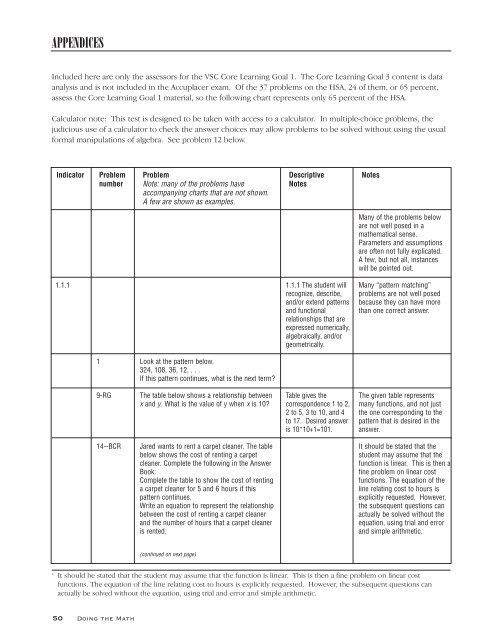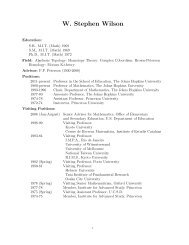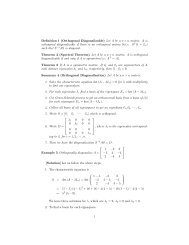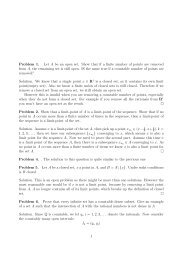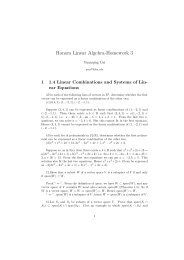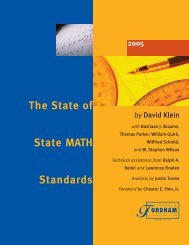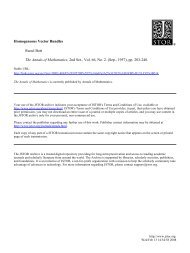Doing the Math - JHU Mathematics - Johns Hopkins University
Doing the Math - JHU Mathematics - Johns Hopkins University
Doing the Math - JHU Mathematics - Johns Hopkins University
You also want an ePaper? Increase the reach of your titles
YUMPU automatically turns print PDFs into web optimized ePapers that Google loves.
APPENDICES<br />
Included here are only <strong>the</strong> assessors for <strong>the</strong> VSC Core Learning Goal 1. The Core Learning Goal 3 content is data<br />
analysis and is not included in <strong>the</strong> Accuplacer exam. Of <strong>the</strong> 37 problems on <strong>the</strong> HSA, 24 of <strong>the</strong>m, or 65 percent,<br />
assess <strong>the</strong> Core Learning Goal 1 material, so <strong>the</strong> following chart represents only 65 percent of <strong>the</strong> HSA.<br />
Calculator note: This test is designed to be taken with access to a calculator. In multiple-choice problems, <strong>the</strong><br />
judicious use of a calculator to check <strong>the</strong> answer choices may allow problems to be solved without using <strong>the</strong> usual<br />
formal manipulations of algebra. See problem 12 below.<br />
Indicator Problem Problem Descriptive Notes<br />
number Note: many of <strong>the</strong> problems have Notes<br />
accompanying charts that are not shown.<br />
A few are shown as examples.<br />
1.1.1<br />
4 It should be stated that <strong>the</strong> student may assume that <strong>the</strong> function is linear. This is <strong>the</strong>n a fine problem on linear cost<br />
functions. The equation of <strong>the</strong> line relating cost to hours is explicitly requested. However, <strong>the</strong> subsequent questions can<br />
actually be solved without <strong>the</strong> equation, using trial and error and simple arithmetic.<br />
50 <strong>Doing</strong> <strong>the</strong> <strong>Math</strong><br />
1<br />
9-RG<br />
14--BCR<br />
Look at <strong>the</strong> pattern below.<br />
324, 108, 36, 12, . . .<br />
If this pattern continues, what is <strong>the</strong> next term?<br />
The table below shows a relationship between<br />
x and y. What is <strong>the</strong> value of y when x is 10?<br />
Jared wants to rent a carpet cleaner. The table<br />
below shows <strong>the</strong> cost of renting a carpet<br />
cleaner. Complete <strong>the</strong> following in <strong>the</strong> Answer<br />
Book:<br />
Complete <strong>the</strong> table to show <strong>the</strong> cost of renting<br />
a carpet cleaner for 5 and 6 hours if this<br />
pattern continues.<br />
Write an equation to represent <strong>the</strong> relationship<br />
between <strong>the</strong> cost of renting a carpet cleaner<br />
and <strong>the</strong> number of hours that a carpet cleaner<br />
is rented.<br />
(continued on next page)<br />
1.1.1 The student will<br />
recognize, describe,<br />
and/or extend patterns<br />
and functional<br />
relationships that are<br />
expressed numerically,<br />
algebraically, and/or<br />
geometrically.<br />
Table gives <strong>the</strong><br />
correspondence 1 to 2,<br />
2 to 5, 3 to 10, and 4<br />
to 17. Desired answer<br />
is 10*10+1=101.<br />
Many of <strong>the</strong> problems below<br />
are not well posed in a<br />
ma<strong>the</strong>matical sense.<br />
Parameters and assumptions<br />
are often not fully explicated.<br />
A few, but not all, instances<br />
will be pointed out.<br />
Many “pattern matching”<br />
problems are not well posed<br />
because <strong>the</strong>y can have more<br />
than one correct answer.<br />
The given table represents<br />
many functions, and not just<br />
<strong>the</strong> one corresponding to <strong>the</strong><br />
pattern that is desired in <strong>the</strong><br />
answer.<br />
It should be stated that <strong>the</strong><br />
student may assume that <strong>the</strong><br />
function is linear. This is <strong>the</strong>n a<br />
fine problem on linear cost<br />
functions. The equation of <strong>the</strong><br />
line relating cost to hours is<br />
explicitly requested. However,<br />
<strong>the</strong> subsequent questions can<br />
actually be solved without <strong>the</strong><br />
equation, using trial and error<br />
and simple arithmetic.


